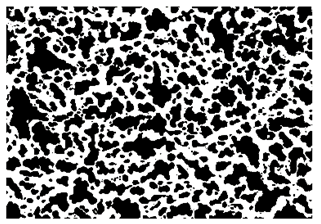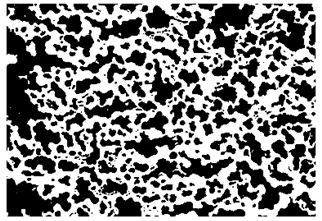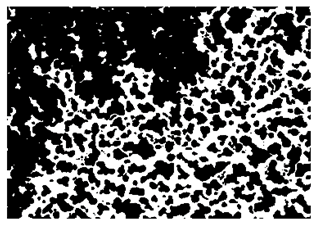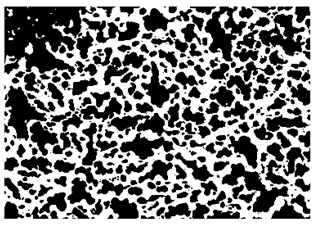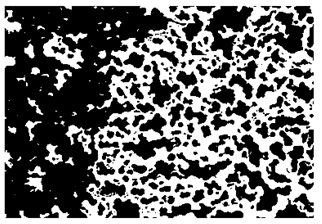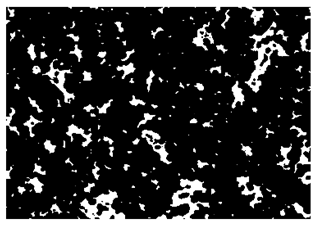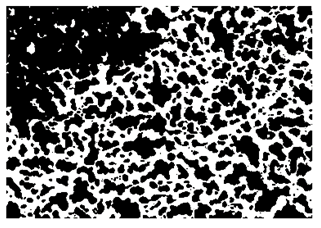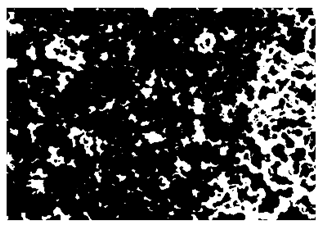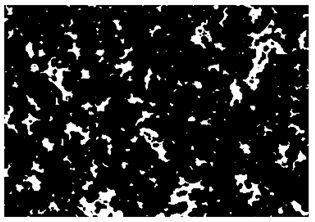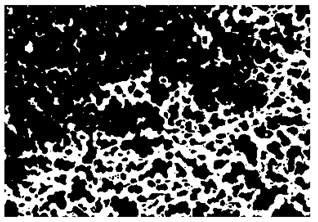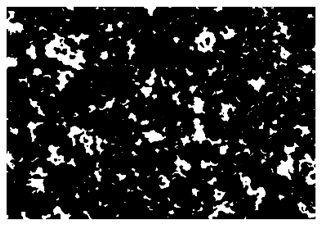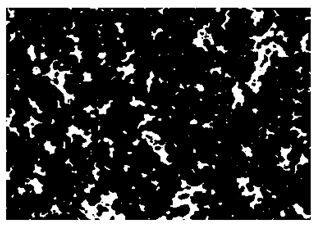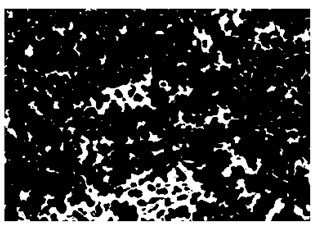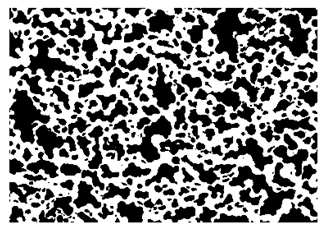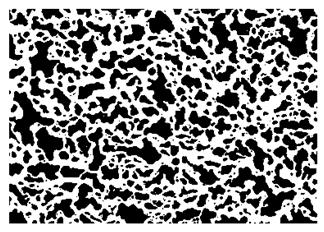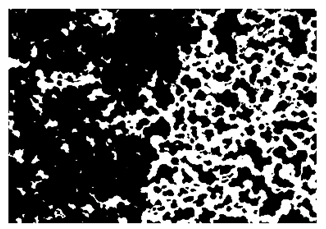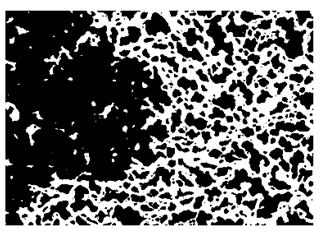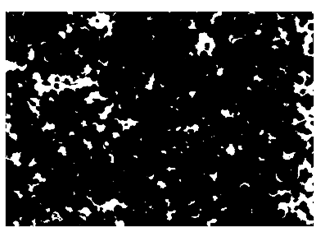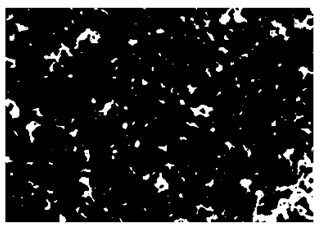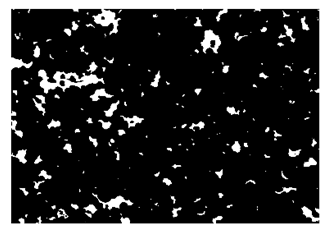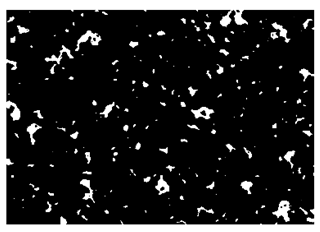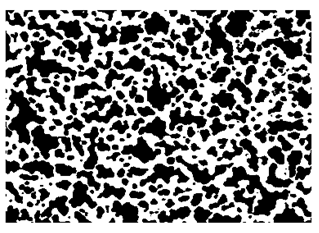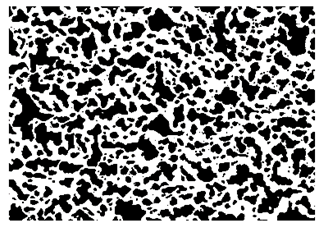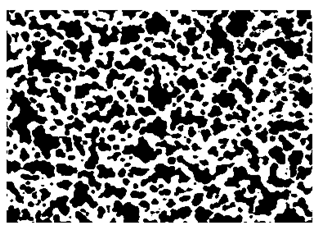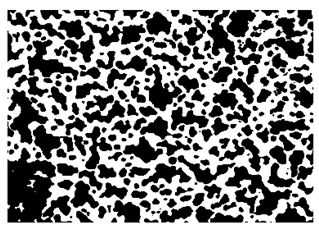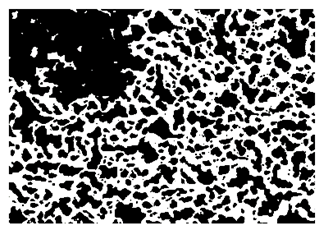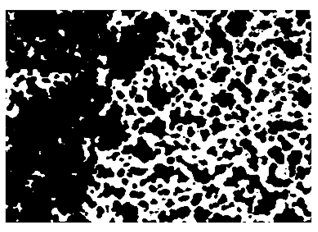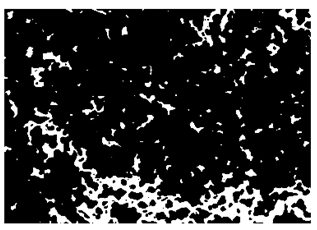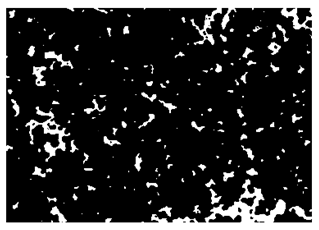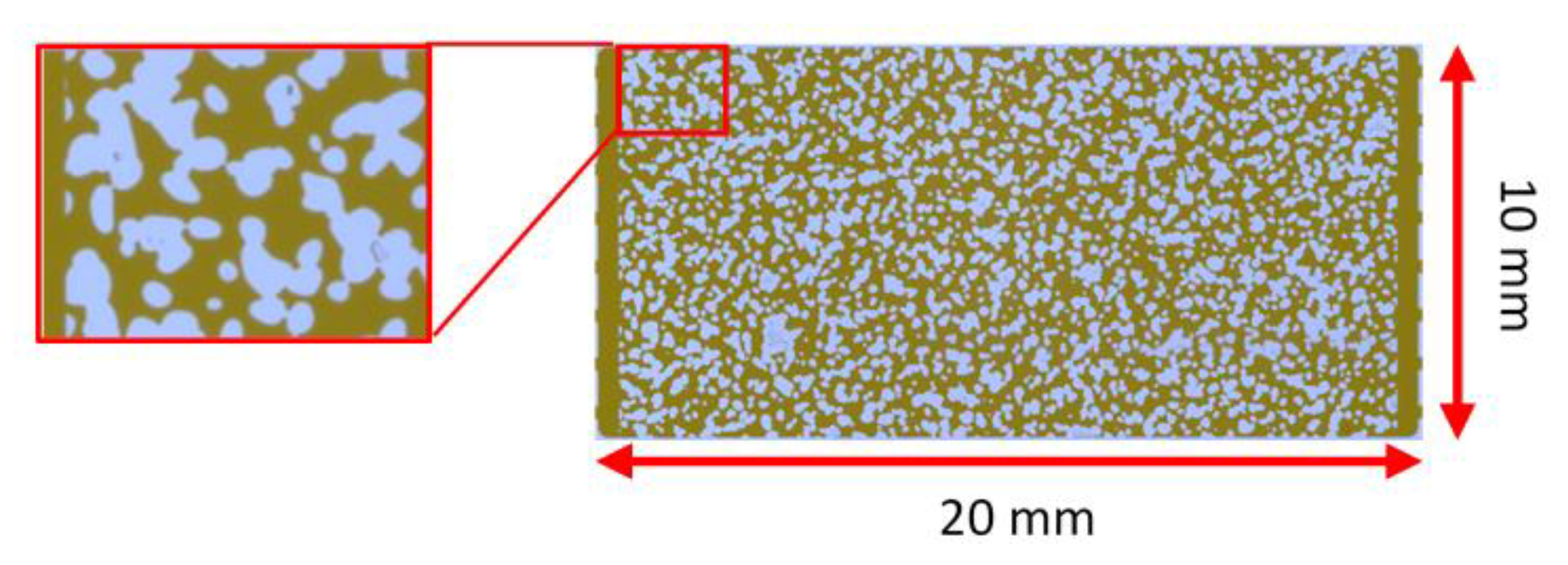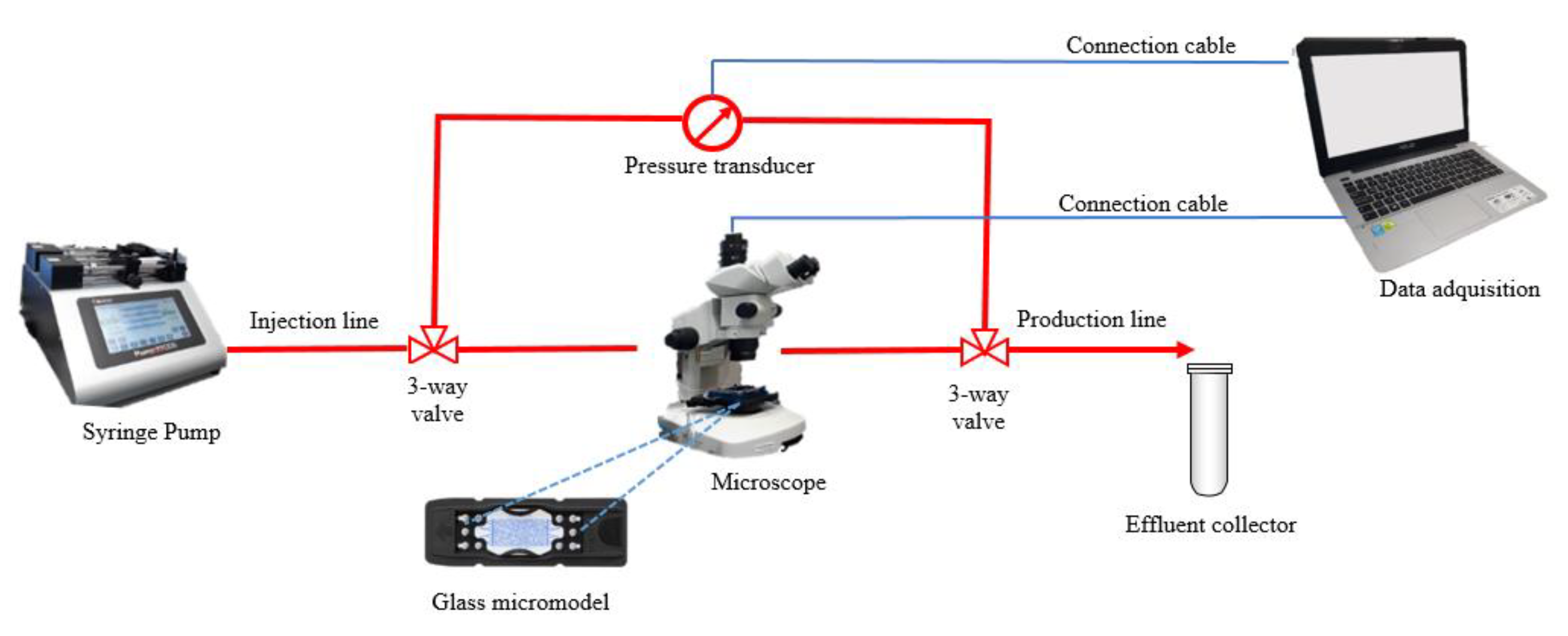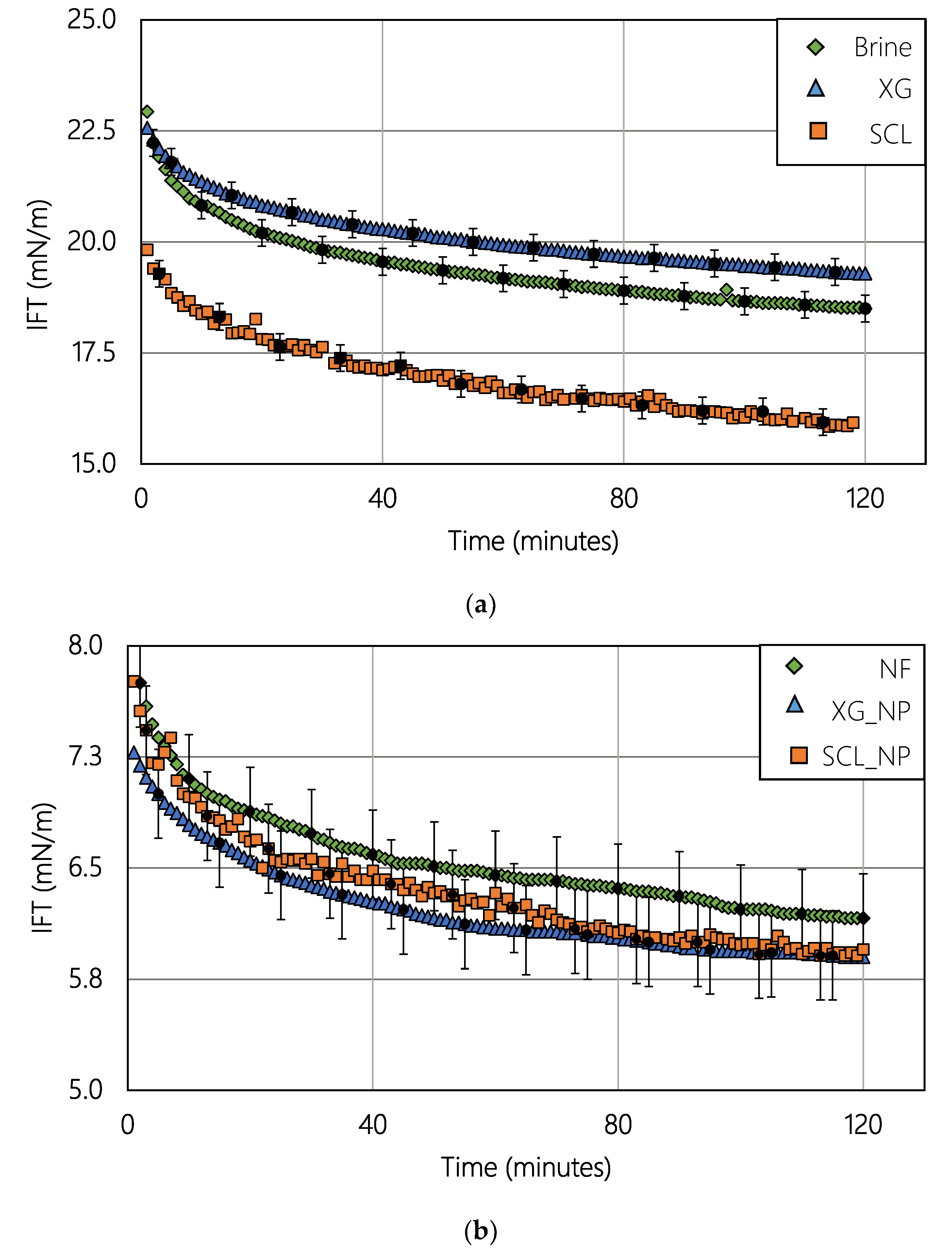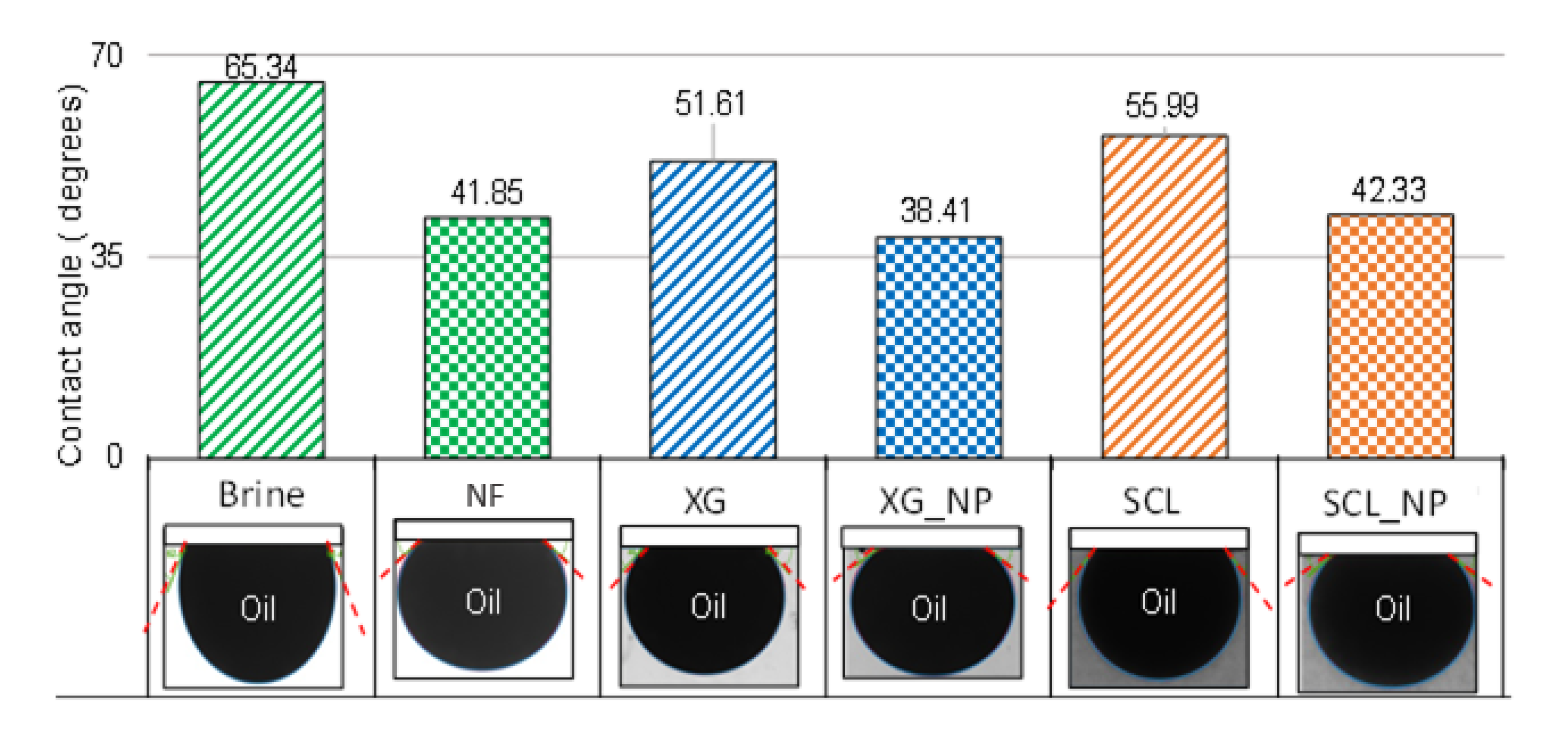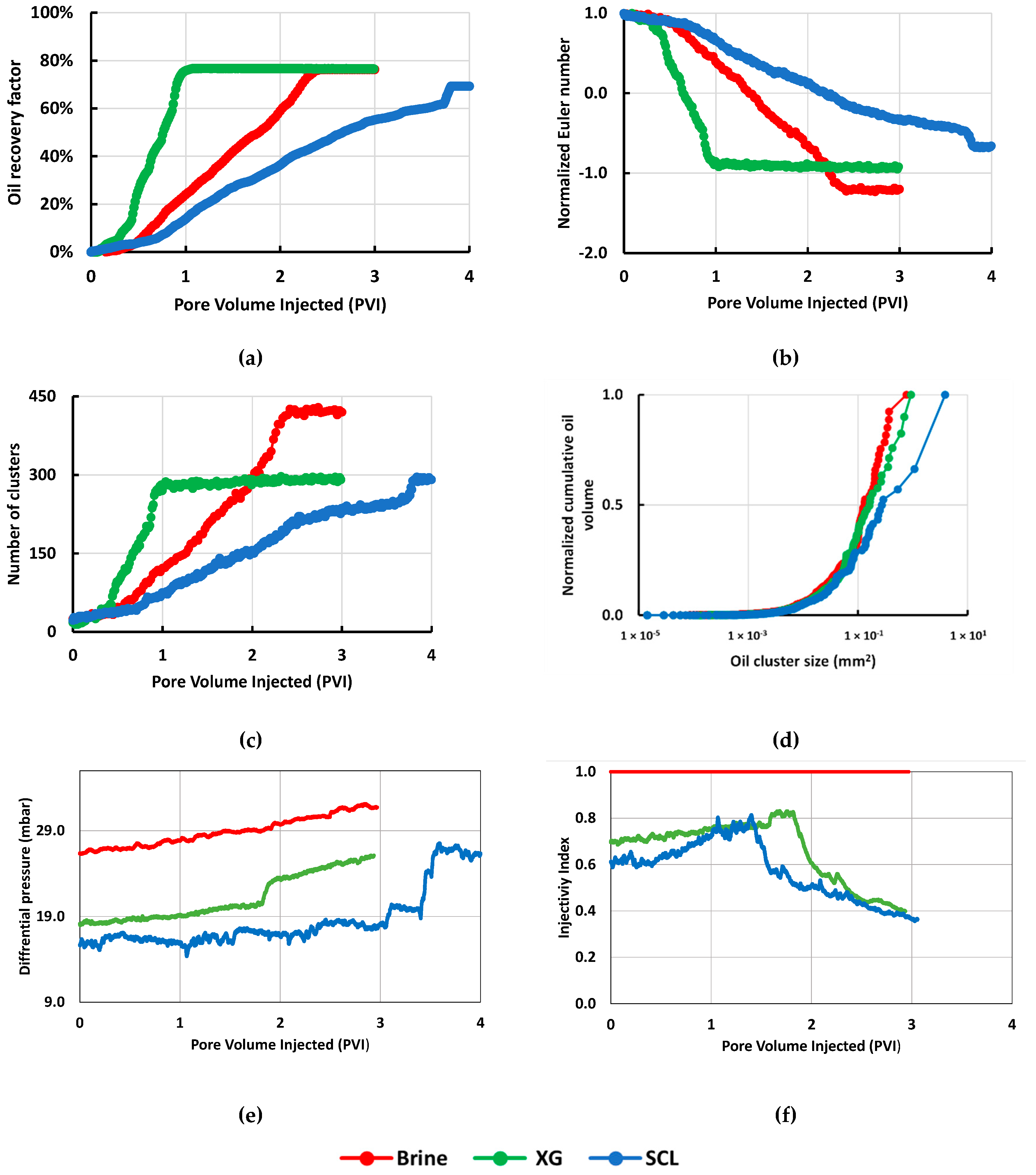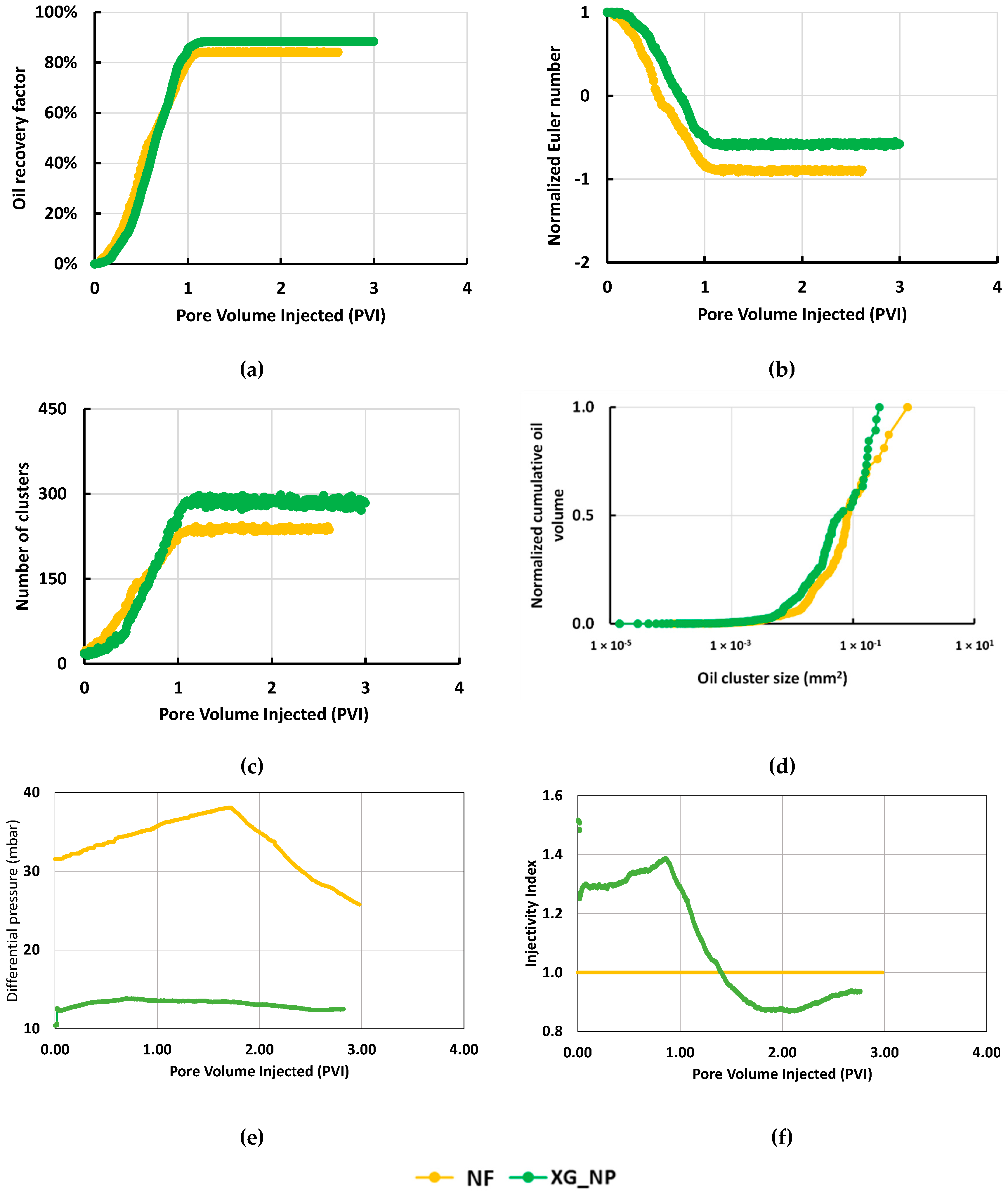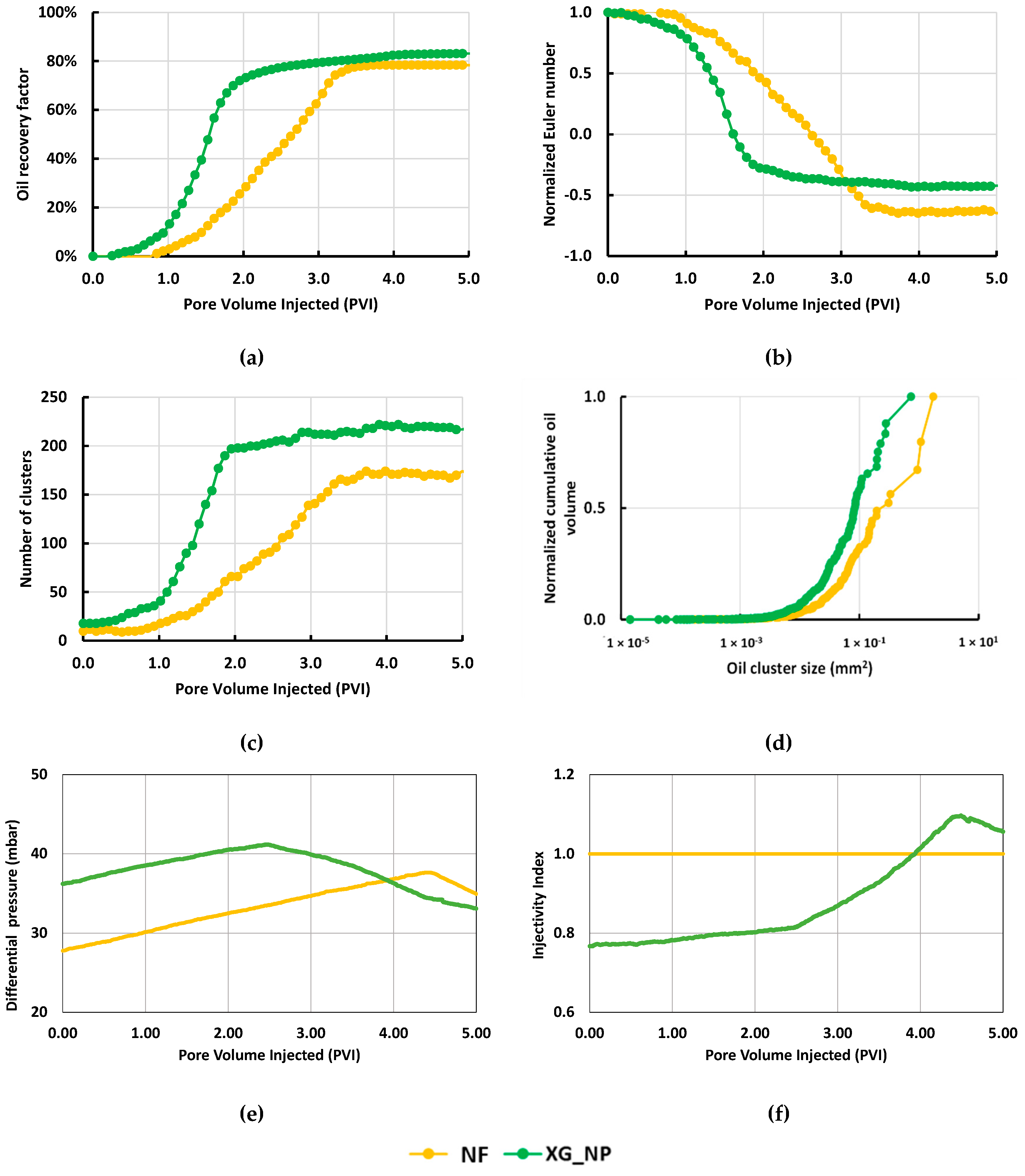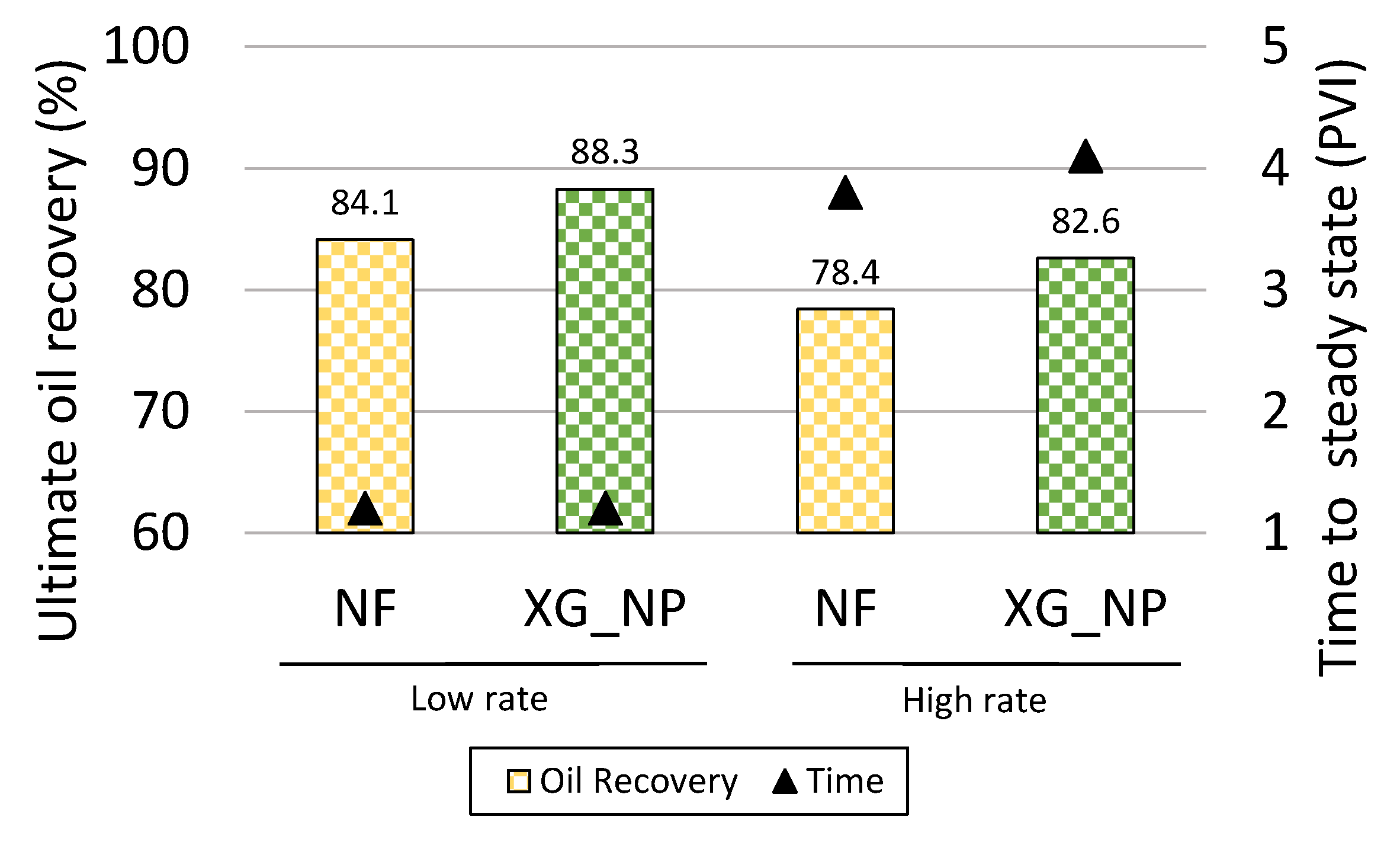1. Introduction
One of the most common enhanced oil recovery (EOR) techniques is polymer flooding. That is described by adding polymer molecules to the aqueous injected phase aiming to increase the viscosity of the solution to be injected, reducing the mobility ratio of water to oil and to controlling the fingering effects. However, polymer waterfloods are highly probable to result in permeability reduction [
1]. In addition, polymer flooding may be considered as an improved waterflooding method rather than an EOR method, since it does not ordinarily unlock the isolated residual oil by water in the porous medium [
2]. The efficiency of a polymer flooding is related to three aspects: (1) the reduction in the injected fluid mobility, (2) polymer alteration of fractional flow curves, and (3) diversion of the injected water from swept areas [
3].
The Xanthan Gum and Scleroglucan are two types of microbial-origin biopolymers. The first polymer is obtained from the microorganism Xanthomas Campestris [
4], and the second is a class of fungal polysaccharides secreted extracellularly by fungi of the genus Sclerotium [
5]. Xanthan Gum is an anionic polymer with an estimated molecular weight of 2.65 Million of Daltons, the Pyruvate and Acetate content are 0.9%, and 3.52%, respectively [
6]. The Scleroglucan is a neutral β-1, 3-β-1,6-glucan. X-ray diffraction shows a triple-helical conformation in the solid-state [
7]. In aqueous solution, the Scleroglucan molecule exists in a stiff, triple-stranded helical structure, where side chains are exposed toward the exterior [
8]. The Scleroglucan molecular weight is approximately 5.2 Million of Daltons [
9].
The biopolymers have been applied in the North Alma Penn unit [
10]. In the early stages of the waterflooding and using concentrations from 250 ppm to 304 ppm, the results showed no damage in the formation, and the decline in the water production in some production wells could be attributed to the positive effect of the biopolymers. In the case of the field Eddesse-Nord sandstone in Germany [
11], the implementation of a Xanthan Gum pilot project at 800 ppm of concentration showed successful injection results, in terms of lower values of adsorption than expected and low degradation effects.
Nanotechnology has received much attention in different engineering disciplines in the oil industry. An important example is the positive impact on the oil recovery factor because of the improvement in the sweep efficiency and reduction in the trapped oil by the capillary pressure [
12,
13,
14]. The four mechanisms investigated in literature as oil displacement mechanisms by NPs are disjoining pressure gradient at oil–NPs interface, the density difference between water and NPs, wettability alteration, and reduction in interfacial tension [
15]. The disjoining pressure is defined as the pressure required to oppose the fluid/solid attractive forces and lift the film from a solid surface. In other words, this pressure represents the net pressure difference between the pressure in a thin film and that in the bulk liquid from which the thin film extends [
16]. The density difference between the nanoparticle and the water drives the particles to agglomerate in the smallest pores and throats. That difference generates an increase in the pressure, which mobilizes the oil in the adjacent pores [
17]. NPs have the ability to alter the wettability from oil-wet to neutral or more water-wet surface [
15]. The use of hydrophilic silica NPs has shown a reduction in the interfacial tension between the brine and oil when the concentration of NPs increases [
18,
19].
In the last decade, the combination of the polymer flooding technique and NPs has been investigated as a promising method to reduce trapping efficiency. NPs (silica NPs, surface-modified silica NPs, or nanoclay) have been added to polymer solutions (hydrolyzed polaycarylamide (HPAM) or Xanthan Gum (XG)) to improve the performance of polymer waterflooding. A micromodel-study presented that silica NPs and HPAM flooding increased the oil recovery by 10% of original oil in place (OOIP) than polymer flooding due to the wettability alteration mechanism [
20]. Another micro-scale study [
21], presented that the efficiency of the pore-to-pore displacement of heavy oil was improved by an increase in the concentration of silica NPs in polaycarylamide (PAM) solutions, even when salt was present in the system. That was explained by ion-dipole interactions between the NPs and cations reducing the polymer degradation. Their study shows that alteration is more effective at lower polymer concentrations. However, for field applications, the use of HPAM is more common than PAM due to dilution problems of PAM. Cheraghian and Khalilinezhad, 2015 [
22] tested the addition of nanoclay (at three concentrations: 0.8, 0.9, and 1.0 wt.%) to polymer flooding (at different concentrations of HPAM) on core-scale. They found that the best recipe resulted in incremental heavy oil recovery by a factor of 5% of OOIP in comparison to polymer flooding after one pore volume fluid injection. Another experimental work showed that silica NPs and nanoclay increased the PAM solution viscosity and decreased its adsorption onto the rock [
23]. The core-scale work by Saha et al., 2018 [
24] showed that nanoparticle assisted polymer (Xanthan Gum) flooding was effective for EOR applications in heavy crude oil systems. Based on the stability analysis of silica NPs, the NPs were more stable in the polymer solution than in water. Besides, the viscosity of the polymer solution improved, and the interfacial tension reduced after the addition of NPs. A considerable improvement in sweep efficiency was observed by adding surface-modified silica NPs to XG solutions, but not to HPAM solutions [
25]. Mohammadi et al., 2019 [
26] studied the effect in the rheology of polymeric solutions with silica NPs. Their results showed that the viscosity of PAM solutions increased when the concentration of NPs was respectively 0.5, 1.0, 1.5, and 2.0 wt.%. A faster increase in thickness occurred when the concentration was higher than 1.5 wt.% at 25 °C. This point corresponds to the critical nanoparticle concentration (CNC). Kennedy et al., 2015 [
27] found in a rheological study that Xanthan Gum exhibited shear-thinning over the entire shear rate range and enhanced the viscosity and the storage moduli with the increasing particle concentration. This phenomenon created larger domains of the associated polymer gel as a result of the interaction between the polymer and the particles.
Microfluidics has become a vital research area in the petroleum industry. It is highly appreciated owing to significantly improving our current understanding of pore-scale displacement events and interactions occurring within tiny fluid volumes, moving within well-defined pore-structures. In addition, it enables capturing the dynamic changes within the medium with a high spatial and temporal resolution. The energy and chemicals fed to a microfluidic setup are much less compared to the core-flooding apparatus, which lowers costs and risks. The heavy and conventional core flooding setup is reduced to a smaller apparatus with a higher level of accuracy and significant observations, more tests can be performed to validated and compare different flooding scenarios and the result takes part in the selection criteria previous to more complex tests like core-flooding.
The ratio of the viscous forces to the capillary forces defined as the capillary number (
Nc), see Equation (1), indicates what forces dominate the flow regime, viscous or capillary flow. Where
Vw is the interstitial velocity,
µ is the viscosity and
σow is the interfacial tension between the fluids involved in the displacement. In conventional brine flooding, the increase in the injection rate (higher capillary number) can reduce the trapped oil in the reservoirs and glass-bead packs [
28,
29]. In the case of fluids with NPs, the tendency is different because the NPs require time to modify the wettability of the surface by disjoining pressure [
29] or because at higher rates the particles agglomerate in the porous media [
13,
29]:
The water injectivity (
Iw) during a water flooding process through a porous media is proposed by Civan, 2016 [
30] in Equation (2) where
qw is the water rate and
ΔP is the pressure difference across the porous medium:
The injectivity index was used in this work to evaluate the effect of each solution during the displacement, according to a reference solution (brine in the case of the fluids without NPs and NPs in the case of the solution with silica NPs). That is calculated using Equation (3):
Modeling these phenomena is challenging. Simulation models need to take into consideration a multi-phase multi-component interactive system. It is necessary to represent the effects of the nanoparticles on the interfacial tension, capillary pressure, and wettability. Polymer flooding also includes interactive phenomena. The non-Newtonian behavior of the polymer solutions requires local and instantaneous determination of the displacing fluid viscosity as a function of shear rate and polymer concentration. However, retention and degradation phenomena strip polymer from the solution, which justifies the multicomponent approach. Changes in local permeability can take place because of polymer adsorption. All those phenomena have recently received close attention, and semi-analytical procedures [
31] or commercial simulators [
32] are progressively coupling their effects on chemical enhanced oil recovery. Nevertheless, the associative contributions of nanoparticles and polymer is new, opening opportunities for developments in this area.
In this work, we study the improvement in the sweep and the displacement efficiencies by the polymer flooding using Xanthan Gum and Scleroglucan assisted with silica NPs. Both phenomena were evaluated independently and simultaneously from two-dimensional (2D) image analysis obtained during microfluidics tests in water-wet glass micromodels and translated in terms of oil recovery factor and injectivity loss. The combination of both chemicals represents an environmentally friendly alternative to improve conventional water flooding. This study also provides new insight into the application of NPs in the oil and gas industry


